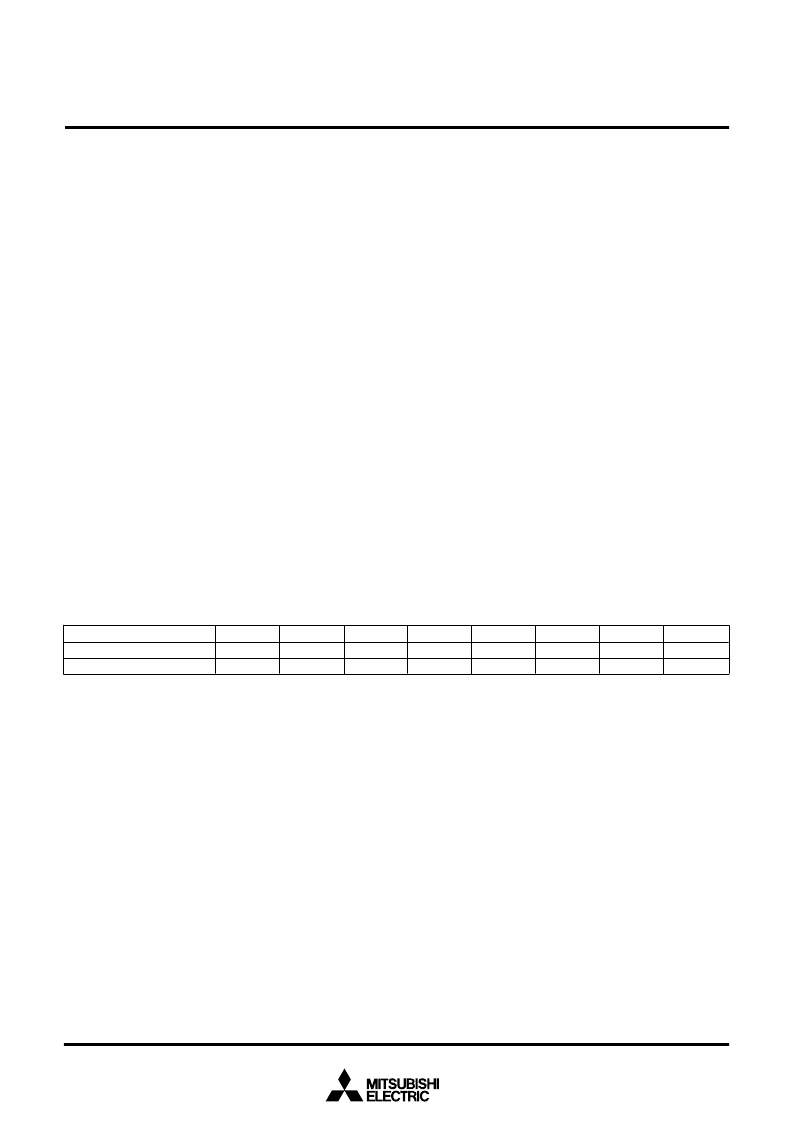- 您現(xiàn)在的位置:買賣IC網(wǎng) > PDF目錄370847 > M37560ME-XXXGP (Mitsubishi Electric Corporation) SINGLE-CHIP 8-BIT CMOS MICROCOMPUTER PDF資料下載
參數(shù)資料
| 型號: | M37560ME-XXXGP |
| 廠商: | Mitsubishi Electric Corporation |
| 英文描述: | SINGLE-CHIP 8-BIT CMOS MICROCOMPUTER |
| 中文描述: | 單芯片8位CMOS微機 |
| 文件頁數(shù): | 10/65頁 |
| 文件大?。?/td> | 955K |
| 代理商: | M37560ME-XXXGP |
第1頁第2頁第3頁第4頁第5頁第6頁第7頁第8頁第9頁當前第10頁第11頁第12頁第13頁第14頁第15頁第16頁第17頁第18頁第19頁第20頁第21頁第22頁第23頁第24頁第25頁第26頁第27頁第28頁第29頁第30頁第31頁第32頁第33頁第34頁第35頁第36頁第37頁第38頁第39頁第40頁第41頁第42頁第43頁第44頁第45頁第46頁第47頁第48頁第49頁第50頁第51頁第52頁第53頁第54頁第55頁第56頁第57頁第58頁第59頁第60頁第61頁第62頁第63頁第64頁第65頁

SINGLE-CHIP 8-BIT CMOS MICROCOMPUTER
MITSUBISHI MICROCOMPUTERS
7560 Group
10
[Processor status register (PS)]
The processor status register is an 8-bit register consisting of 5
flags which indicate the status of the processor after an arithmetic
operation and 3 flags which decide MCU operation. Branch opera-
tions can be performed by testing the Carry (C) flag , Zero (Z) flag,
Overflow (V) flag, or the Negative (N) flag. In decimal mode, the Z,
V, N flags are not valid.
Bit 0: Carry flag (C)
The C flag contains a carry or borrow generated by the arith-
metic logic unit (ALU) immediately after an arithmetic operation.
It can also be changed by a shift or rotate instruction.
Bit 1: Zero flag (Z)
The Z flag is set if the result of an immediate arithmetic operation
or a data transfer is
“
0
”
, and cleared if the result is anything other
than
“
0
”
.
Bit 2: Interrupt disable flag (I)
The I flag disables all interrupts except for the interrupt gener-
ated by the BRK instruction.
Interrupts are disabled when the I flag is
“
1
”
.
Bit 3: Decimal mode flag (D)
The D flag determines whether additions and subtractions are
executed in binary or decimal. Binary arithmetic is executed
when this flag is
“
0
”
; decimal arithmetic is executed when it is
“
1
”
.
Decimal correction is automatic in decimal mode. Only the ADC
and SBC instructions can be used for decimal aritmetic.
Bit 4: Break flag (B)
The B flag is used to indicate that the current interrupt was gen-
erated by the BRK instruction. The BRK flag in the processor
status register is always
“
0
”
. When the BRK instruction is used to
generate an interrupt, the processor status register is pushed
onto the stack with the break flag set to
“
1
”
.
Bit 5: Index X mode flag (T)
When the T flag is
“
0
”
, arithmetic operations are performed be-
tween accumulator and memory. When the T flag is
“
1
”
, direct
arithmetic operations and direct data transfers are enabled be-
tween memory locations.
Bit 6: Overflow flag (V)
The V flag is used during the addition or subtraction of one byte
of signed data. It is set if the result exceeds +127 to -128. When
the BIT instruction is executed, bit 6 of the memory location op-
erated on by the BIT instruction is stored in the overflow flag.
Bit 7: Negative flag (N)
The N flag is set if the result of an arithmetic operation or data
transfer is negative. When the BIT instruction is executed, bit 7
of the memory location operated on by the BIT instruction is
stored in the negative flag.
Table 5 Set and clear instructions of each bit of processor status register
C flag
SEC
CLC
Set instruction
Clear instruction
Z flag
–
–
I flag
SEI
CLI
D flag
SED
CLD
B flag
–
–
T flag
SET
CLT
V flag
–
CLV
N flag
–
–
相關PDF資料 |
PDF描述 |
|---|---|
| M37560MF-XXXFP | CAP 68UF 100VDC FILM POWER |
| M37630E4FP | Connector |
| M37630M4T-XXXFP | SINGLE-CHIP 8-BIT CMOS MICROCOMPUTER |
| M37630M4T-XXXFS | SINGLE-CHIP 8-BIT CMOS MICROCOMPUTER |
| M37640M4T | SINGLE-CHIP 8-BIT CMOS MICROCOMPUTER |
相關代理商/技術參數(shù) |
參數(shù)描述 |
|---|---|
| M37560MF | 制造商:MITSUBISHI 制造商全稱:Mitsubishi Electric Semiconductor 功能描述:SINGLE-CHIP 8-BIT CMOS MICROCOMPUTER |
| M37560MF-324GP | 制造商:Renesas Electronics Corporation 功能描述: |
| M37560MF-330GP | 制造商:Renesas Electronics Corporation 功能描述: |
| M37560MFA-XXXFP | 制造商:RENESAS 制造商全稱:Renesas Technology Corp 功能描述:SINGLE-CHIP 8-BIT CMOS MICROCOMPUTER |
| M37560MFA-XXXGP | 制造商:RENESAS 制造商全稱:Renesas Technology Corp 功能描述:SINGLE-CHIP 8-BIT CMOS MICROCOMPUTER |
發(fā)布緊急采購,3分鐘左右您將得到回復。